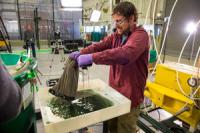-
Vibrator maker to pay out $3 million for tracking users' sexual activity
We-Vibe, the sex toy maker, has agreed to pay customers up to $7,600 each selling them a “smart vibrator” which tracked the customers’ sexual habits without their knowledge. A class-action lawsuit was filed against in an Illinois federal court against We-Vibe’s parent company, Standard Innovation. Standard Innovation has been ordered to pay a total of $3 million to owners of the vibrator who had also used the app associated with the vibrators (the tracking of customers was done by the app).
-
-
Making mobile transactions more secure with a quantum key system

With the growing popularity of mobile phone apps to pay for purchases at cash registers and gas pumps, users would like to know their personal financial information is safe from cyber-attacks. For the first time, researchers have demonstrated a prototype device that can send unbreakable secret keys from a handheld device to a terminal. If integrated into a cell phone, for example, the device could allow secure links to near-field communications mobile payment systems and indoor Wi-Fi networks. It also could improve the security of ATMs and help prevent ATM skimming attacks, which are estimated to cost the industry more than $2 billion annually.
-
-
A First: U.S. brings hacking charges against two Russian government officials
The United States, for the first time, has brought hacking charges against Russian government officials. The charges include hacking, wire fraud, trade secret theft and economic espionage. The Justice Department has previously charged Russians with cybercrime – and brought prosecutions against hackers sponsored by the Chinese and Iranian governments – but the new indictments are the first time a criminal case is being brought against Russian government officials.
-
-
ADL to build Silicon Valley center to monitor, fight cyberhate
The Anti-Defamation League (ADL) has secured seed funding from Omidyar Network to build a state-of-the-art command center in Silicon Valley to combat the growing threat posed by hate online. The center will employ the best technology and seasoned experts to monitor, track, analyze, and mitigate hate speech and harassment across the Internet, in support of the Jewish community and other minority groups.
-
-
Cyberterrorism threat must be addressed: Pool Re’s chief
Cyber is unlike any other peril, because of its theoretical ability to affect almost any insurance class. This significantly impairs (re)insurers’ ability to allocate capital, to model losses with confidence, and, as a result, to price insurance products accurately. The gap between the available global insurance capacity and market exposure has become increasingly stark: market capacity stands at approximately $500 million, but the exposure is estimated to be more than $130 billion. Pool Re, the U.K.’s $7.3 billion terrorism reinsurance fund, wants to extend its cover to include cyberattacks on property, chief executive Julian Enoizi said.
-
-
Misaligned incentives, executive overconfidence create advantages for cyberattackers

New report outlines how cybercriminals have the advantage, thanks to the incentives for cybercrime creating a big business in a fluid and dynamic marketplace. Defenders on the other hand, often operate in bureaucratic hierarchies, making them hard-pressed to keep up. Attackers thrive in a fluid, decentralized market, while bureaucracy constrains defenders. Ninety-three percent of organizations surveyed have a cybersecurity strategy, but only 49 percent have fully implemented it. Nearly 60 percent of IT executives believe their cybersecurity strategy is fully implemented, while just over 30 percent of IT staff agree. Senior executives designing cyber strategies measure success differently than implementers.
-
-
Reusable sponge could revolutionize oil spill and diesel cleanup

When the Deepwater Horizon drilling pipe blew out seven years ago, beginning the worst oil spill in U.S. history, those in charge of the recovery discovered a new wrinkle: the millions of gallons of oil bubbling from the sea floor weren’t all collecting on the surface where it could be skimmed or burned. Some of it was forming a plume and drifting through the ocean under the surface. Now, scientists have invented a new foam, called Oleo Sponge, that addresses this problem.
-
-
Ukrainian businessman with links to Trump, Russia dies in mysterious circumstances
Alex Oronov, 69, a Ukranian-born millionaire businessman with ties to both Donald Trump and the Russian business elite, has died on 2 March in unexplained circumstances. Oronov, a naturalized American citizen, ran a large agricultural business in his native Ukraine. Oronov also had family ties to Michael Cohen, Donald Trump’s personal lawyer: Cohen’s brother, Bryan, was Oronov’s partner in an ethanol business in Ukraine. Oronov’s death is the latest in a series of mysterious deaths which have visited senior Russian diplomats in the past three months.
-
-
Up to $600 billion in American intellectual property stolen annually

The theft of American intellectual property (IP) remains a systemic threat to the U.S. economy, inflicting an estimated cost that exceeds $225 billion in counterfeit goods, pirated software, and theft of trade secrets and could be as high as $600 billion annually. China remains the world’s principal IP infringer, driven by an industrial policy that continues to prioritize both acquisition and development of science and technology.
-
-
Serious security vulnerabilities found in home, business, industrial robots
Researchers have identified numerous vulnerabilities in multiple home, business, and industrial robots available on the market today. The vulnerabilities identified included many graded as high or critical risk, leaving the robots susceptible to cyberattack. Once a vulnerability has been exploited, a hacker could potentially gain control of the robot for cyber espionage, turn a robot into an insider threat, use a robot to expose private information, or cause a robot to perform unwanted actions when interacting with people, business operations, or other robots. In the most extreme cases, robots could be used to cause serious physical damage and harm to people and property.
-
-
Tsunami pod to the rescue

What if you are a coastal dweller and you hear a tsunami warning – but you have no way, or no time, to run for high ground before the wave hits. What if there are no tall, sturdy buildings nearby? Mukilteo, Washington-based Survival-Capsule has a solution: A tsunami pod. The Survival Capsule is a patent-pending, personal safety system (PSS) is a spherical ball to protect against tsunami events, tornadoes, hurricanes, earthquakes, and storm surges.
-
-
Loss of territory contributes to significant drop in ISIS funding

Islamic State’s income has more than halved since 2014, due to its shrinking territory in Syria and Iraq and subsequent losses of significant sources of revenue, according to a new study. Whilst it is impossible to say exactly how much money Islamic State has at its disposal, findings show that the most significant sources of revenue are closely tied to the territory it controls. Most recent evidence suggests that total income from taxes/extortion, oil, kidnapping, antiquities, looting, and confiscations has decreased from up to $2 billion in 2014 to less than $800 million in 2016. There is also no evidence that the group has been successful in creating new sources of revenue.
-
-
How governments and companies can prevent the next insider attack
Insider threats could take many forms, such as the next Edward Snowden, who leaked hundreds of thousands of secret documents to the press, or the next Nidal Hasan, the Fort Hood mass killer. Indeed, in today’s high-tech and hyperconnected world, threats from insiders go far beyond leakers and lone-wolf shooters. A single insider might be able to help adversaries steal nuclear material that terrorists could use to make a crude nuclear bomb, install malware that could compromise millions of accounts or sabotage a toxic chemical facility to cause thousands of deaths. How can we better protect against the enemy within, no matter what it is that needs to be protected? In our high-tech society, the insider threat is ever-present. High-security organizations, governments and companies alike need to take action to counter the organizational and cognitive biases that often blind us to the insider danger – or future blunders will condemn us to more disasters.
-
-
Preferential trade agreements bolster global trade at the expense of its resilience
The global commodity trade is a complex system where its network structure, which may arise from bilateral and multilateral agreements, affects its growth and resilience. At time of economic shocks, redundancy in this system is vital to the resilience of growth.
-
-
Increase in arms transfers driven by demand in the Middle East, Asia
The volume of international transfers of major weapons has grown continuously since 2004 and increased by 8.4 percent between 2007–11 and 2012–16, according to new data on arms transfers published today by the Stockholm International Peace Research Institute (SIPRI). Notably, transfers of major weapons in 2012–16 reached their highest volume for any five-year period since the end of the cold war.
-
More headlines
The long view
If Trump Wants More Deportations, He’ll Need to Target the Construction Industry
As President Donald Trump sends mixed messages about immigration enforcement, ordering new raids on farms and hotels just days after saying he wouldn’t target those industries, he has hardly mentioned the industry that employs the most immigrant laborers: construction. Almost a quarter of all immigrants without a college degree work in construction.
Federal R&D Funding Boosts Productivity for the Whole Economy − Making Big Cuts to Such Government Spending Unwise
Large cuts to government-funded research and development can endanger American innovation – and the vital productivity gains it supports. If the government were to abandon its long-standing practice of investing in R&D, it would significantly slow the pace of U.S. innovation and economic growth.
Smaller Nuclear Reactors Spark Renewed Interest in a Once-Shunned Energy Source
In the past two years, half the states have taken action to promote nuclear power, from creating nuclear task forces to integrating nuclear into long-term energy plans.
